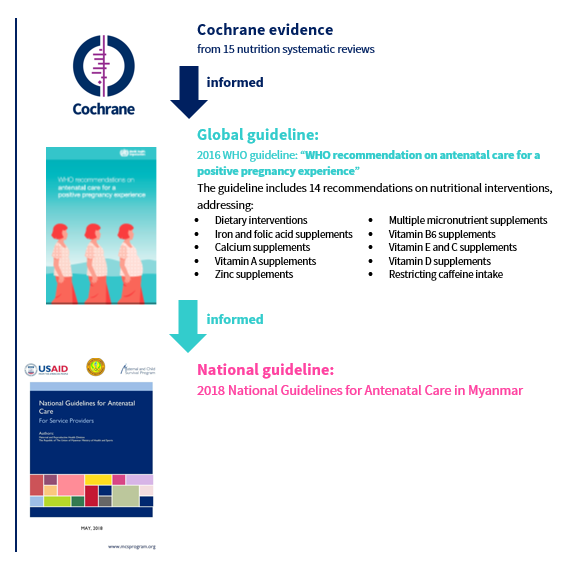
Trusted evidence. Informed decisions. Better health.
Cochrane Nutrition Newsletter | 2019, Issue 3
Guest Editorial
Evidence to address the global epidemic of childhood obesity
by Nigel Rollins
The double burden of malnutrition, where child undernutrition co-exists with overweight and obesity within the same populations, communities and even families, is a paradox that is set to become more visible and challenging in the decades ahead. Today, 124 million children and adolescents are obese, a ten-fold increase over the last 40 years.(1) About 18.4% and 6.8% of school-aged children are, respectively, overweight and obese. In the Americas, every other school-aged child is either overweight or obese and a similar pattern is evolving in the Western Pacific. Urbanisation, less active, more sedentary lifestyles and the power of commercial interests over infant and child food systems will further fuel the epidemic unless action is taken by families, civil society, health providers and policy-makers.
The consequences for obese children and adolescents are both immediate and lifelong. These children do not enjoy the same health and psychosocial development as their non-obese counterparts; they suffer stigmatisation and do not play and explore as other children do. Their future well-being is also jeopardised. Childhood obesity is associated with increased risks of non-communicable disease (NCD) including cardiovascular disease, diabetes and cancer. Of the premature deaths attributable to NCDs, 85% occur in low- and middle-income countries. (2)
The evidence for interventions to effectively treat obese children and adults is uniformly disappointing. Prevention must therefore be the priority. However, this is complicated because of the nature of food systems and commercial interests, lack of awareness at individual and societal level, and far-reaching socio-economic factors. Despite these challenges, there is evidence, albeit imperfect, to support action today. (3) Taxation of sugar-sweetened beverages, improving labelling of foods and regulation of commercial interests and advertising are being implemented in some settings; increased physical exercise and reducing sedentary lifestyles are explicitly recommended among young children; protecting and supporting breastfeeding and quality complementary foods remain important for all child health including to reduce the risk of obesity; growth patterns in the mid-child years can be screened to identify at risk children and trigger support for families; awareness and commitment in civil society and among policy-makers should prioritise and mobilise investments for preventive interventions.
Finally, there is the observational evidence for the developmental origins of health and disease hypothesis that suggests the health and nutrition of mothers’ preconception and through pregnancy influence the lifetime health trajectories of children, including their responses to obesogenic exposures. Increased risk of cardiovascular disease and type-2 diabetes have been reported among infants born to mothers who smoked, were obese or had gestational diabetes, were themselves low birth weight or large for gestational age. Fulfilling Koch’s postulates to establish causality means that interventions are tested. However, without reliable biomarkers in early childhood that accurately predict metabolic health in adulthood, research designs will be complex and studies long in their duration to assess impact.
Generating and synthesising evidence, for example, with respect to physical activity in young children (4) or policy interventions such as taxation of sugar-sweetened beverages (5), needs to be at the centre of policy and programme development in response to this public health crisis that also requires donors and researchers to coordinate better to improve efficiencies and shorter time to results.
References
- NCD Risk Factor Collaboration. Worldwide trends in body-mass index, underweight, overweight, and obesity from 1975 to 2016: A pooled analysis of 2416 population-based measurement studies in 128.9 million children, adolescents, and adults. Lancet. 2017;390:2627-42.
- World Health Organization. Global health estimates 2016: Deaths by cause, age, sex, by country and by region, 2000-2016. Geneva: World Health Organization, 2018.
- Commission on Ending Childhood Obesity. Report of the commission on ending childhood obesity. Geneva: World Health Organization, 2016.
- Carson V, Lee EY, Hewitt L, Jennings C, Hunter S, Kuzik N, et al. Systematic review of the relationships between physical activity and health indicators in the early years (0–4 years). BMC Public Health. 2017;17(Suppl 5):854.
- Heise TL, Katikireddi SV, Pega F, Gartlehner G, Fenton C, Griebler U, Sommer I, Pfinder M, Lhachimi SK. Taxation of sugar-sweetened beverages for reducing their consumption and preventing obesity or other adverse health outcomes. A protocol. Cochrane 2016. https://www.cochranelibrary.com/cdsr/doi/10.1002/14651858.CD012319/full
 |
About the author Dr Nigel Rollins is based at the Department of Maternal, Newborn, Child and Adolescent Health of the World Health Organization, since 2008. His work focuses primarily on implementation research and the growth and development of children including infant feeding. He is also involved with broader paediatric issues including health systems research and severe malnutrition. |
New nutrition reviews in the Cochrane Library
 |
What is the effect of point-of-use fortification of foods with micronutrient powders (MNP) containing iron in children of preschool & school age?
|
 |
Animal-source foods for growth and development in children |
|
|
Physical activity, diet and other behavioural interventions for improving cognition and school achievement in children and adolescents with obesity or overweight Read more about the review here.
|
Can probiotics prevent and reduce the severity of infantile colic?
This review included six studies in 1886 newborn infants less than one month of age who were not diagnosed with infantile colic when they entered a study. Two studies examined Lactobacillus reuteri DSM, two examined multi‐strain probiotics, one examined Lactobacillus rhamnosus, and one examined Lactobacillus paracasei and Bifidobacterium animalis. Findings include effects on the occurrence of infantile colic, crying time and adverse effects.
Read more about the review here.
What are the effects of zinc supplementation to prevent pneumonia in children?
This updated review included six studies that investigated zinc supplements to prevent pneumonia conducted in Bangladesh, India, Peru and South Africa and involved 5193 children. Studies assessed oral zinc supplements containing at least the USA's recommended daily allowance of zinc versus either an oral supplement without zinc or placebo, administered for at least three months and outcome assessment was carried out for at least four weeks.
Read more about the review here.
Lipid-based nutrient supplements (LNS) plus complementary foods in infants and young children
This review included 17 studies with 23 200 children from Malawi, Bangladesh, Ghana, Burkina Faso, Haiti, Honduras, Chad, Congo, Kenya, Niger, Peru, Guatemala, and Indonesia. The review assessed non‐hospitalised infants and children, aged six to 23 months, and studied effects of LNS plus complementary foods on improving growth outcomes and reducing the occurrence of children who are of short stature for their age (stunting), have low weight for their age (moderate underweight), have low weight for their height (moderate wasting) and anaemia.
Read more about the review here.
Environmental interventions to reduce the consumption of sugar‐sweetened beverages
Researchers looked at the results from 58 studies that assessed approaches and strategies aimed at changing the physical or social environment where people consume or buy sugary drinks at a population level. The studies were done in various settings, including schools, cafes, restaurants, homes, and retail outlets and were conducted in 19 countries in North and South America, Australasia, Europe and South East Asia. The broad categories of interventions studied included labelling, nutrition standards, price increases and subsidies, home-based interventions, interventions aimed at the whole food supply, retail and food services, and intersectoral approaches such as food benefit programs and trade and investment policies.
Read more about the review here.
Nutrition Evidence in Action
Evidence can be put into action by informing health policy and care. High quality systematic reviews are an important source of evidence for evidence-informed recommendations. A core World Health Organization function is developing global guidelines to contribute to improved health policy and care. Global guidelines should be adapted, if necessary, and implemented at regional, national or sub-national levels. Here we present an example, using the figure below, where 15 Cochrane nutrition reviews informed a global WHO guideline on antenatal care, which then informed a national-level guideline on antenatal care in a lower-middle income country, Myanmar.

News
African Cochrane Indaba, 2019
Cochrane South Africa hosted the 3rd African Cochrane Indaba (ACI) in Cape Town, South Africa on 25-26 March 2019 which brought together continental and international leaders in evidence-informed decision making for healthcare. The theme was ‘Trusted evidence for better health decisions in Africa and the Indaba aimed to share knowledge, experiences and skills for evidence-informed policy making and knowledge translation in Africa. The Indaba was attended by 109 delegates from 17 countries and included international speakers and facilitators. The programme consisted of four plenaries; 51 posters; eight workshops and one panel discussion. Cochrane nutrition presented two posters at the meeting: ‘Assessing the completeness of outcomes in systematic reviews addressing food availability: a pilot study’ and ‘Accessible Cochrane nutrition evidence: ‘Implementing ‘packaging and push’ and ‘facilitating pull’.
Cochrane Nutrition at the WHO/Cochrane/Cornell Summer Institute, 2019
The 6th WHO/Cochrane/Cornell Summer Institute for systematic reviews in nutrition for global policy-making was held from 15 to 26 July 2019at the Ithaca campus of Cornell University in the United States. This institute brings together experts from the World Health Organization (WHO), Cochrane, and Cornell University to train participants in the preparation of systematic reviews of nutrition interventions, and Celeste Naude, Co-Director of Cochrane Nutrition, introduced participants to Cochrane Nutrition, highlighted the importance of robust nutrition systematic reviews to support evidence-informed decision-making, and shared some of Cochrane Nutrition’s key activities.
Cochrane Nutrition meeting at the 26th Cochrane Colloquium
Join us at the Cochrane Nutrition meeting that will take place during the 26th Cochrane Colloquium in Santiago, Chile. Please keep an eye out for the date and time of the meeting in the Colloquium's programme.
Upcoming conferences
What works global summit (WWGS) 2019
16-18 October, Mexico City, Mexico. Find out more here
25th Cochrane Colloquim
22 - 25 October 2019, Santiago, Chile. Find out more here.
REWARD | EQUATOR Conference 2020
20-22 February 2020, Berlin, Germany. Find out more here.
WPHNA 2020 conference
31 March - 3 April 2020, Queensland, Australia. Find out more here.
17th International Conference on Clinical Nutrition
4 - 5 May 2020, Singapore. Find out more here.
4th International Conference on Global Food Security
Achieving local and global food security: at what costs?
16-19 June 2020, Montpellier, France. Find out more here.
International Congress of Dietetics
15 - 18 September 2020, Cape Town. Find out more here.
Publications
Recommendations for data collection, analysis and reporting on anthropometric indicators in children under 5 years old
The World Health Organization and the United Nations Children's Fund (UNICEF) has published a report with recommendations for data collection, analysis and reporting on anthropometric indicators in children under five years old. This document provides guidance to enhance the quality of reporting for the global nutrition targets (childhood stunting, wasting and overweight) and the SDG target 2.2 of ending of all forms of malnutrition by 2030.
Read the report here.
Food environments: Where people meet the food system
The 44th edition of the flagship publication of United Nation Standing Committee on Nutrition (Food environments: Where people meet the food system) has been released. This edition "explores the contexts in which consumers engage with the food system when making decisions on acquiring, preparing and consuming food, as well as the impact of the food environment on their dietary choices". Safe and supportive environments for nutrition are one of the six actions areas of the Decade of Action on Nutrition (2016-2025), and this report appropriately discusses various perspectives around the concept and role of food environments.
Access the publication here.
Follow us on Twitter: @cochranenutri
Join Cochrane Nutrition as a contributor
Contribute to our Newsletter: Email requests to cochranenutrition@sun.ac.za

